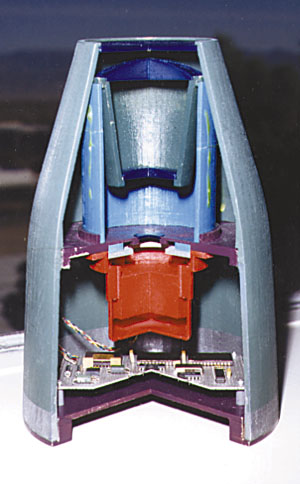
Ran in The Weaponeer on February 18, 1999
ONR takes quantum leap with DAMASK
By Pam Harris
TID

|
|---|
| DAMASK prototype |
China Lake, CA-The Navy and Air Force are partnering with industry to develop an accuracy-enhancement kit for the Joint Direct Attack Munition (JDAM). According to Howard McCauley, technical direction agent for the Direct Attack Munitions Affordable Seeker (DAMASK) Fleet Advanced Demonstration (FAD), the accuracy enhancement kit will take the form of a seeker of the lowest possible cost that will improve JDAM accuracy to three-meter circular error probability (CEP).
DAMASK includes a very low-cost sensor mounted to the front of a JDAM and an off-the-shelf signal processor mounted in the existing JDAM tail kit. During the final stages of weapon flight, DAMASK's unique guidance system will image the target area, locate a mission-planned aimpoint and update the JDAM target location so that the JDAM can steer to within three meters CEP of it.
This Office of Naval Research (ONR)-sponsored, high-risk, $15 million project focuses on seeker cost from a system standpoint. To dramatically reduce the cost of traditional seeker systems, all moving parts were removed, resulting in a fully strapped-down seeker. To further reduce the cost, the DAMASK seeker is enclosed in a glass-filled, injection-molded, composite housing. It uses an uncooled imaging-infrared focal plane array (UIIFPA) sensor and low-cost optics, both developed for the consumer automobile market. An off-the-shelf, commercially available signal processor is the final component of the accuracy upgrade kit, estimated to cost less than $12.7 thousand per seeker in quantity.
The fully strapped-down seeker requires a unique guidance strategy. First, a desired impact point is specified during JDAM mission planning by simply clicking on it in an image of the target area. This mission-planning image can come from satellite, uninhabited air vehicles or reconnaissance aircraft. A template is then automatically produced from the mission-planning image and loaded on board the aircraft with the baseline JDAM mission plan. Organic targeting is possible because the target area can be imaged with onboard synthetic aperture radar (SAR) or forward looking infrared (FLIR) sensors, and the pilot can then select the desired impact point using a heads-down display.
The JDAM is then flown into the launch acceptability region and delivered. DAMASK turns on when the weapon is in its final seconds of flight. DAMASK images the target area and compares the image with the template produced during mission planning to locate the desired impact point. An aimpoint estimator uses the information from the signal processor to calculate seeker-to-inertial-measurement unit (IMU) alignment to one tenth of a milliradian and, at the same time, to estimate the desired impact point to 2.6 meters. Calculation of seeker alignment is required, because DAMASK uses the baseline JDAM IMU mounted in the tail, and complex alignment procedures during weapon buildup are undesirable. After the impact point is estimated, the information is fed back to the JDAM guidance computer. JDAM then steers to the new position.
The Navy, represented by ONR and the Naval Air Warfare Center Weapons Division (NAWCWD) and the Air Force, represented by Eglin Air Force Base, are leading the effort, based on their joint expertise in system engineering, seeker hardware development, safety-of-flight evaluation and signal-processing hardware and software development.
McCauley has assembled a development team that spans many disciplines - from system acquisitions to guidance and control. In addition to the military, DAMASK is being supported by several industry partners.
The Boeing-McDonnell Missile System Division, St. Louis, Mo., will integrate the seeker onto the JDAM. Raytheon, Dallas, Texas, and Alliant TechSystems, Hopkins, Minn., are developing sensor and low-cost optics technologies. Sverdrup, Ridgecrest, is developing the guidance and control strategy.
The three-year FAD began in FY 98 and continues through FY 00. During FY 98, contracts were awarded to industrial partners, system requirements were identified and the preliminary and critical design reviews were completed. A free-stream, wind-tunnel data collection and analysis effort was successful, a signal-processing-in-the-loop facility was built, safe-separation flight clearance was started and UIIRFPA sensor technologies were characterized.
An unanticipated task tackled this year involved measuring and evaluating weapon system flexure, so that the airframe could be modeled and the effects of flexure on airframe performance could be predicted.
McCauley and his co-workers faced some tough challenges during the first year.
"First, we had to develop a guidance-and-control strategy for a low-cost seeker with no moving parts, and one that can `plug and play' in the existing JDAM bomb," McCauley confided.
Barry Niesen and Randy Sturgeon brainstormed a novel guidance strategy that uses Global Positioning System (GPS) and Inertial Navigation System (INS) guidance information, coupled with unique pattern-matching algorithms and signal processing. Mike Wirtz and Rod Ditzler tailored their own pattern- matching algorithms to the DAMASK environment and tackled the problems encountered when an UIRFPA sensor is strapped onto a bomb.
Motion-induced blur and distortion are just some of the challenges that they have faced. They also had to modify their algorithms to provide roll alignment estimates, because the aimpoint estimator could not provide that information as part of the seeker alignment estimate.
The primary challenge to the team was in keeping DAMASK truly "low-cost." They spent endless hours researching available commercial off-the-shelf technologies. Led by Gerald Jones, DAMASK's Hardware Team shattered paradigms by choosing a window/lens/IR sensor assembly developed by Raytheon for Cadillac as the DAMASK sensor package. The sensor package is enclosed in an injection molded polymer housing formed with the same techniques used to manufacture most plastic parts in automobiles.
In FY 99, the seeker will be built and tested in a series of simulated, captive-carry, and free-flight tests. In FY 00 the signal processing algorithms will be integrated and two full-up rounds will be demonstrated.
When queried about the outcome of the effort, McCauley stated, "I have no doubt that DAMASK will work. Failure is not an option."
-END-


